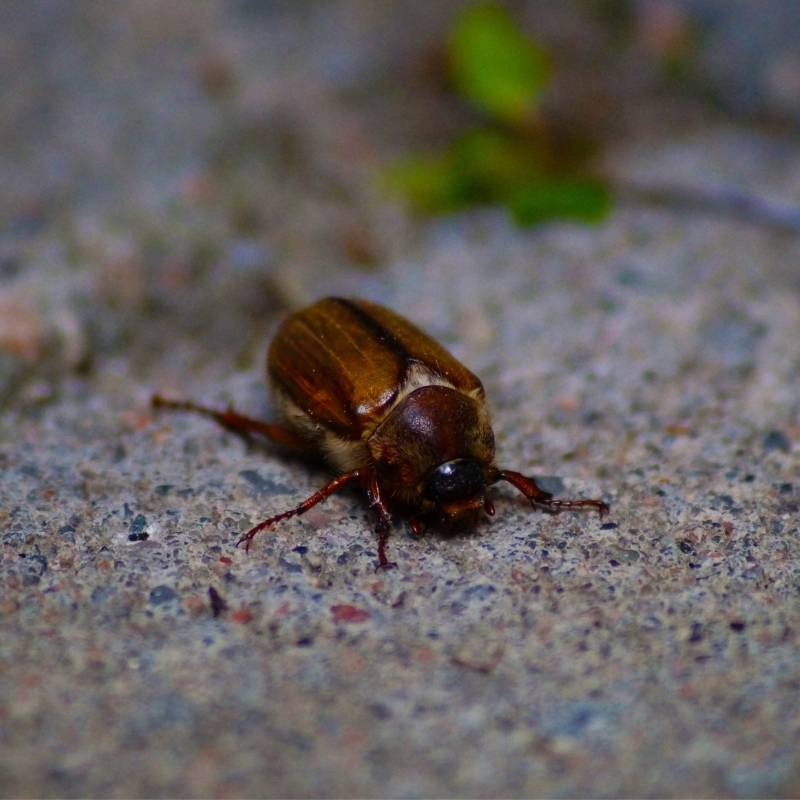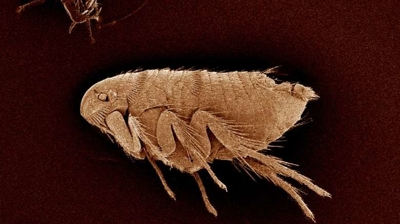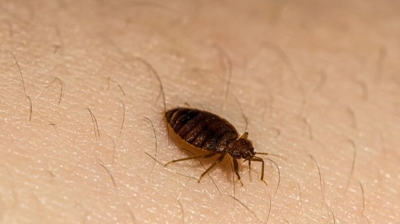
June Beetles

Are June Beetles Harmful?
June beetles, also called June bugs, can be considered harmful in several ways, primarily through their feeding habits and their life cycle:
- Damage to Lawns and Turf: June beetle larvae live in soil and feed on the roots of grasses and other plants. This can cause brown patches or dead spots in lawns, weakening of turf, making it more susceptible to drought and disease, and increased vulnerability to other pests, such as birds or raccoons, which dig up the lawn to eat the grubs.
- Damage to Crops and Garden Plants: Grubs feeding on roots can stunt or kill garden plants, vegetable crops, and ornamental plants by severing root systems. Adult beetles feed on foliage. Some species chew on leaves of shrubs, trees, or garden plants, though this is usually less severe than grub damage.
- Attracting Predators: Grubs are a high-protein food source for birds, skunks, raccoons, and moles. While not harmful directly, these animals can cause additional damage to lawns and gardens while foraging.
- Nuisance Factor: Adult June beetles are attracted to lights at night, sometimes in large numbers, which can be a nuisance around homes. Their large size and clumsy flight can make them startling or bothersome to people.
The harm from June beetles comes mostly from the larval stage feeding on plant roots, leading to weakened plants, lawn damage, and indirect damage from animals that feed on them. Adults are less destructive but can still be a nuisance.
Learn more: Do June Beetles Bite? || What Do June Beetles Eat?
June Beetle Removal
Getting rid of June beetles is important because of the significant damage they can cause to both plants and property. Adult June beetles themselves are mostly harmless, feeding on foliage at night, but the real problem lies in their larvae, commonly known as white grubs. These grubs live in the soil and feed on the roots of grasses, ornamental plants, and crops. Heavy infestations can lead to brown patches in lawns, weakened or dying trees and shrubs, and reduced crop yields in agricultural settings.
In addition to direct plant damage, June beetle infestations can indirectly invite other pests. For instance, birds, raccoons, and skunks often dig up lawns to feed on the grubs, causing further destruction to turf and landscaping. Moreover, because grubs damage root systems, affected plants become more susceptible to drought, disease, and environmental stress, compounding the long-term impact.
In commercial and residential contexts, unchecked June beetle populations can lead to expensive lawn repair, tree replacement, and crop losses. Early intervention is therefore critical, as the life cycle of June beetles allows larvae to overwinter in soil, making infestations persistent if not addressed. Controlling both adults and larvae with integrated pest management strategies—such as soil treatments, biological controls, and habitat management—helps prevent widespread damage and preserves the health of lawns, gardens, and agricultural crops.
Learn more: How To Get Rid Of June Beetles
June Beetle Control
Hiring our professional pest control for June beetles is strongly recommended:
- Accurate Identification: June beetles can resemble other beetle species, and some pests that appear similar may require different treatment approaches. Our professionals correctly identify the species and determine whether it’s the adult beetles, their larvae (grubs), or both that are causing problems.
- Targeting the Root of the Problem: The larvae (grubs) of June beetles live in soil and feed on grass roots, which can cause significant lawn and garden damage. Our professionals know how to treat both the adults and larvae effectively. Over-the-counter solutions often only address the visible adult beetles, leaving the grubs to continue damaging the lawn.
- Integrated Pest Management (IPM) Expertise: Our professionals use a combination of cultural and chemical methods that minimize harm to non-target plants, pets, and beneficial insects. For example, we time insecticides that reduce beetle populations without affecting pollinators.
- Proper Timing and Application: June beetle populations are seasonal. Adults emerge in late spring to early summer, and larvae develop in soil over months. We know the optimal timing to apply treatments so they’re most effective, avoiding wasted effort or repeated applications.
- Preventing Secondary Damage: If left untreated, June beetle grubs can weaken lawns, making them more susceptible to disease, drought stress, and invasive weeds. This can escalate repair costs far beyond the cost of our professional pest control.
- Safety and Compliance: Our professionals are trained in the safe handling and application of pesticides. Using chemicals improperly can pose risks to humans, pets, and the environment, and may even violate local regulations.
- Long-Term Monitoring: We provide follow-up visits and monitoring programs. This ensures that infestations are kept under control year after year, rather than temporarily suppressed.
Our professional pest control for June beetles ensures precise identification, effective treatment at the right stage of the beetle’s life cycle, and protection of your lawn and garden while minimizing risks to people, pets, and beneficial insects. The expertise and follow-up care of our professionals saves time, money, and frustration compared to DIY methods.
June Beetle Exterminators
Hiring our local exterminators for June beetles offers several key advantages over using a national pest control company:
- Knowledge of Local Conditions: Our local exterminators understand the specific species of June beetles common in the area, their seasonal activity, and the local environmental factors that influence infestations. We know which treatments work best for your soil type, climate, and landscape, whereas national companies often use standardized approaches that may not be optimized for your region.
- Tailored Treatment Plans: Because local professionals see the area firsthand, they can provide customized solutions. This includes identifying hotspots in your lawn or garden, timing treatments to target larvae before they cause root damage, and adjusting chemical or biological controls based on local regulations and soil conditions. National companies may rely on cookie-cutter schedules that don’t account for local nuances.
- Faster Response and Ongoing Support: Local exterminators can respond quickly to urgent infestations, monitor progress, and make follow-up visits without the logistical delays that large companies often have. This is particularly important for June beetles, since larvae develop underground and require precise timing for effective control.
- Accountability and Reputation: Local businesses rely heavily on community reputation. They are motivated to provide thorough, professional service because word-of-mouth and local reviews directly affect their success. National companies may have less personal accountability, and you can often get lost in the bureaucracy when problems arise.
- Cost Efficiency: Working with a local exterminator can reduce overhead costs and unnecessary add-ons. Many national companies include extra services in standard packages that you may not need, while local professionals can focus exactly on the problem at hand.
- Environmentally Conscious Solutions: Local exterminators are often more aware of eco-sensitive approaches that work in your specific area. They can recommend integrated pest management strategies, like beneficial nematodes or targeted soil treatments, reducing the reliance on broad-spectrum pesticides.
For pests like June beetles, where larvae can do significant damage if not treated promptly and correctly, these advantages make local expertise not just convenient but crucial for effective control and long-term prevention.
June Beetle Solutions
Our exterminators use Integrated Pest Management (IPM) to control June beetles because their larvae, commonly called white grubs, feed on the roots of lawns, gardens, and crops, causing significant damage, while adults can be a nuisance around lights at night. IPM begins with a thorough inspection to identify infestation levels, locate breeding and feeding sites, and determine the species involved. Management strategies combine cultural practices, such as proper lawn care, soil aeration, and removal of decaying plant matter, with biological controls like beneficial nematodes or microbial agents that specifically target grubs. Targeted chemical treatments may be applied selectively when infestations are severe. Regular monitoring allows our exterminators to assess the effectiveness of treatments, detect new activity early, and adjust interventions accordingly. By integrating inspection, habitat management, precise control measures, and ongoing monitoring, IPM provides a long-term, environmentally responsible, and effective solution for managing June beetle populations.
What Do June Beetles Look Like?
June beetles, also known as June bugs, have a distinctive appearance that makes them fairly recognizable. Here’s a detailed description:
- Size: Adult June beetles are usually between 12 to 25 millimeters (about 0.5–1 inch) long, though this can vary by species.
- Color: Most species are reddish-brown to dark brown on top, with a shiny, hard exoskeleton. Some may appear almost black. The underside is typically lighter.
- Body Shape: They have a broad, oval, and slightly convex body, giving them a robust look.
- Wings: They possess two pairs of wings. The front pair (elytra) is hard and protects the membranous hind wings used for flying.
- Legs: Their legs are spiny and adapted for digging, which is useful when laying eggs in the soil or when larvae (grubs) burrow underground.
- Antennae: June beetles have clubbed antennae, which can fan out into leaf-like structures used for sensing pheromones.
If you see one at night, it may be attracted to lights, which is a common behavior for June beetles.
Where Are June Beetles Found?
June beetles are most commonly found in areas that provide suitable conditions for both the adult beetles and their larval stage (grubs):
- Lawns and Gardens: The grubs live underground in soil, feeding on roots of grass, ornamental plants, and crops. Areas with well-irrigated, healthy lawns are particularly attractive because the soil is soft and full of roots. Grub activity often leads to patchy brown spots in lawns where grass dies off.
- Fields and Agricultural Areas: June beetles are common in cornfields, pastures, and other crop areas, because larvae feed on roots and adults feed on foliage. They can occasionally cause noticeable damage in crops like corn, soybeans, or small grains.
- Wooded and Shady Areas: Adults may be found on trees, shrubs, and other plants, especially at night, because many species are nocturnal. They are attracted to tree leaves, fruit trees, and ornamental shrubs where they feed lightly.
- Near Lights: Adult June beetles are strongly attracted to lights at night, so you may see them around porch lights, streetlights, or outdoor lighting in late spring and early summer.
- Soil Type: Soft, sandy, or loamy soil is ideal for laying eggs, so areas with well-drained soil are more likely to host grubs.
You’re most likely to encounter grubs underground in lawns and gardens, while the flying adults are common near lights, trees, and shrubs, particularly in late spring to early summer.
June Beetle Life Cycle
The life cycle of June beetles (or June bugs) is a multi-stage process that typically spans one to three years, depending on the species. Understanding their life cycle is key to controlling them effectively, since different stages occupy different environments and cause different types of damage:
Egg Stage
- Timing: Eggs are usually laid in late spring to early summer by adult females.
- Location: Eggs are deposited in the soil, often in lawns, gardens, or fields with rich, loose soil.
- Appearance: Small, white or cream-colored, oval eggs.
- Duration: Eggs hatch in about 2–6 weeks, depending on soil temperature and moisture.
Larval Stage (Grubs)
- Appearance: Creamy-white, C-shaped grubs with a brown head and six legs near the front.
- Diet: Feed on roots of grasses, crops, and ornamental plants, which is the stage that causes the most noticeable damage.
- Habitat: Live underground, usually in the top few inches of soil.
- Duration: This stage can last 1–3 years, depending on the species and environmental conditions.
- Behavior: Grubs burrow through soil, weakening plant roots. Lawn damage appears as brown patches that can be pulled up easily.
Pupal Stage
- Timing: Typically occurs late spring, after the larvae have matured.
- Location: Pupation happens in the soil, in a small chamber created by the larva.
- Duration: Lasts a few weeks. During this time, the grub transforms into an adult beetle.
Adult Stage
- Appearance: Reddish-brown to dark brown, oval-shaped beetles, ½–1 inch long.
- Diet: Adults feed on leaves of trees and shrubs at night.
- Behavior: Nocturnal and attracted to lights. Adults usually live for 1–2 months, during which they mate and lay eggs, completing the cycle.
- Timing: Most adults appear in late spring to early summer, which is why they’re called “June beetles.”

Hear From Our Happy Customers
-
"Exceeds Expectations"
I can’t say enough positive things about this company... The tech that came out, Jarvis went above and beyond my expectations. Thank you guys, I will continue using your services.
- Jake M. -
"Very Knowledgeable"
The tech that arrived was courteous, professional, and very knowledgeable. He was Great.
- Uerial I. -
"Great Communication"
Tech was on time, communication was great, and he accommodated my needs.
- Alonzo W. -
"Professional & Considerate"
I’m pleased with Miche services. Jarvis came today. Professional and considerate. Thank you!
- Judy B. -
"Fantastic & Patient"
Jarvis was fantastic and patient. He answered my questions with an in-depth explanation and addressed all of my areas of concern. Would love for him to be my assigned tech going forward. Well done!
- Yonnette M. -
"Wonderful Service"
Wonderful service. Jarvis is great. Took care of everything I needed. Thank you!
- Henry P.



